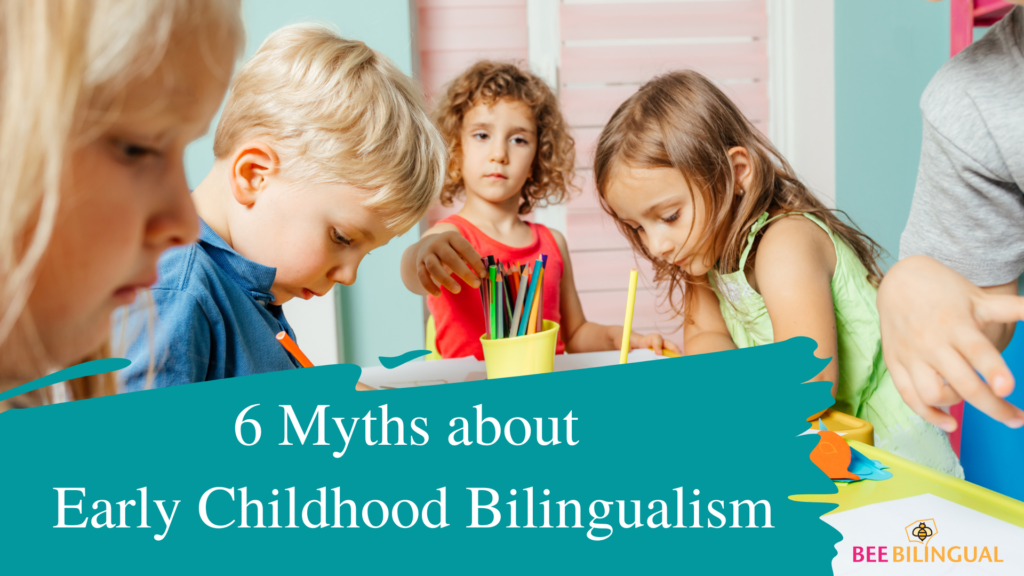As parents raising bilingual children, we often strive to develop their fluency in both languages. However, we understand that it can be challenging to ensure that the minority language receives sufficient attention and practise. Everyday life is often taken over by the majority language that is spoken around us. Yet, it is incredibly important to continue building on children’s minority language knowledge, even if it isn’t as consistent as you would like.
Spoken fluency is a crucial aspect of language development, allowing children to confidently communicate in their second language. In this blog post, we will explore eight effective strategies to build up spoken fluency in the minority language of your bilingual child.
8 Strategies to Nurture the Minority Language
1.Consistent Language Exposure
Consistency is key when nurturing spoken fluency in the minority language. You wonder how to do it? It’s actually quite straightforward. Create a language-rich environment by incorporating the language into your daily routines and activities. Speak the minority language at home, maintain regular conversations, and encourage your child to respond in the same language. Consistent exposure to the language ensures that your child becomes familiar with its sounds, vocabulary, and sentence structures. For example, you and your bilingual learner could listen to music in the minority language, perhaps on the drive to school. You could also do a daily Storytime that always involves a storybook in the minority language. Check out our bilingual checklist for more inspiration!
2.Quality Language Interaction
Engage in meaningful conversations with your child, focusing on quality language interaction. Actively listen to their responses, ask open-ended questions, and encourage them to express their thoughts and feelings in the minority language. Create opportunities for discussions, debates, and storytelling sessions, where your child can practice their language skills and build confidence in their spoken fluency. Praise but don’t over-praise! Encourage minority language use (even when it isn’t perfect) but don’t focus on mistakes and problems. Remember: Language learning should be fun!
3.Language Playdates and Immersion
If possible, arrange playdates or group activities with other children who speak the minority language. Of course, language lessons are also a great option! Immersion in a social setting provides your child with opportunities to practice their language skills naturally. Encourage them to interact, play, and collaborate using the minority language. Such experiences promote fluency and help your child feel more comfortable and confident speaking the language with their peers.
4.Cultural Experiences
To enhance spoken fluency, expose your child to the culture associated with the minority language. If possible, go on regular holidays in the country in which the minority language is spoken. You could also attend cultural events, explore traditions, and celebrate holidays from the language’s culture. Engaging in cultural experiences helps your child develop a deeper understanding and connection to the language, making them more motivated to communicate fluently and authentically.
5.Language Apps and Online Resources
I must admit, I’m a big fan of language apps such as Duolingo. Especially if your child is used to regular tablet or computer use, you should harness the power of technology to support your child’s language learning journey. Explore language-learning apps and online resources designed specifically for children. Many of these resources incorporate interactive exercises, games, and stories that make language learning engaging and enjoyable. Encourage your child to use these tools regularly, as they provide additional practice and reinforcement outside of formal language learning settings.
6.Reading and Storytelling
Reading aloud and storytelling are powerful tools for developing spoken fluency. We even have dedicated an entire blog post on the benefits of reading to bilingual learners. Introduce a wide range of books, comics, and age-appropriate literature in the minority language. Make reading sessions interactive by asking questions, discussing characters and plots, and encouraging your child to predict what happens next. Encourage them to retell stories or create their own narratives, fostering their oral expression and language fluency. If you are reading picture books with your little learner, you could even discuss the illustrations, colours and shapes.
7.Role-Play and Dramatization
Harness the power of imagination by engaging your child in role-play and dramatization activities. They are so much fun! Encourage them to act out scenarios, play different characters, and engage in pretend play using the minority language. This playful approach not only enhances vocabulary and fluency but also boosts their confidence and creativity in expressing themselves orally. Encourage them to dress up, use props … you could even help them to build their own stage background!
8.Support from Native Speakers
Seek opportunities for your child to interact with native speakers of the minority language. Look for language exchange programs, conversation partners, or tutors who can engage in conversations and activities in the target language. There are also fantastic language teachers for kids online! Regular interactions with native speakers provide invaluable exposure to authentic pronunciation, intonation, and cultural nuances, which contribute significantly to spoken fluency. And, of course, all important grammar aspects are covered and discussed by language teachers.
Remember, fluency takes time and practice, so be patient and encouraging throughout the journey. Celebrate your child’s progress and milestones (go for a ice cream, for example or buy them a new book!), and provide a nurturing environment where they feel comfortable and motivated to use the minority language. By investing in their spoken fluency, you are opening doors to a world of cultural richness, improved communication skills, and enhanced opportunities for your bilingual child.



